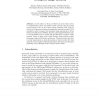240 search results - page 42 / 48 » Forest for the trees |
JCB
2006
13 years 7 months ago
2006
We describe a novel method for efficient reconstruction of phylogenetic trees, based on sequences of whole genomes or proteomes, whose lengths may greatly vary. The core of our me...
ICDM
2006
IEEE
14 years 1 months ago
2006
IEEE
A Spatio-Temporal Association Rule (STAR) describes how objects move between regions over time. Since they describe only a single movement between two regions, it is very difficu...
IPPS
2010
IEEE
13 years 5 months ago
2010
IEEE
Abstract--The now commonplace multi-core chips have introduced, by design, a deep hierarchy of memory and cache banks within parallel computers as a tradeoff between the user frien...
ECIR
2009
Springer
14 years 4 months ago
2009
Springer
In this paper, we study how to automatically exploit visual concepts in a text-based image retrieval task. First, we use Forest of Fuzzy Decision Trees (FFDTs) to automatically ann...
CLEF
2008
Springer
13 years 9 months ago
2008
Springer
In this article, we focus our efforts (i) on the study of how to automatically extract and exploit visual concepts and (ii) on fast visual diversity. First, in the Visual Concept D...

